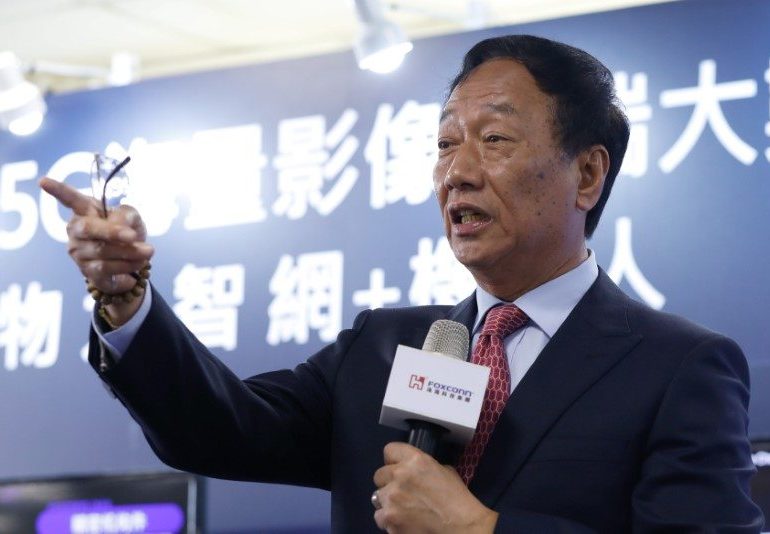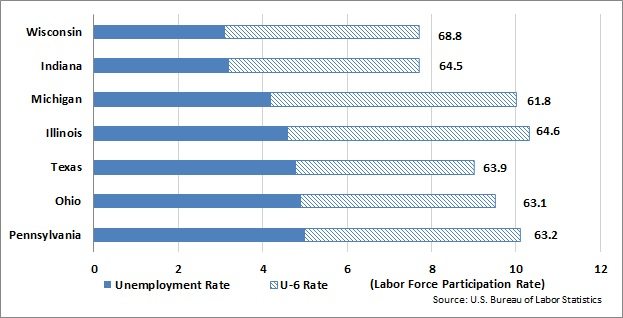Taiwanese technology manufacturer Foxconn is considering plans to locate “up to 10,000 jobs” in southeastern Wisconsin, state Assembly leaders wrote in a transportation related memo to business groups on Wednesday.
The memo from Assembly Speaker Robin Vos, Majority Leader Jim Steineke and Joint Finance Committee co-chair John Nygren was the clearest indication from government officials about the potential size of the Foxconn project in Wisconsin.
The company’s interest in Wisconsin began to come to light after President Donald Trump mentioned ongoing negotiations during an event June 13 at Waukesha County Technical College.
The Assembly memo was aimed at finding a transportation funding solution for the state budget. The authors pointed out that even with Foxconn’s interest in the state “the enumeration of I-94 North-South through Racine and Kenosha counties continues to be delayed.”
Ahead of the competition
Lawmakers might be looking to find additional money for the state’s transportation projects, but if Foxconn picks Wisconsin, they along with the business and education communities might be asking another question: Where are 10,000 workers going to come from?
“Governor Walker believes Wisconsin has the hardest working, most dedicated workforce in the world,” said Tom Evenson, a spokesman for the governor, in response to an inquiry about attracting new companies amid challenges for existing companies to find help. “Other businesses are relocating to Wisconsin and future job and wage opportunities attract more people to fill the demand.”
While transportation infrastructure is a top concern for many companies considering a new location, so too is a region’s workforce. Highway accessibility ranked as the most important site selection factor in Area Development’s 2016 survey of corporate executives, just ahead of availability of skilled labor which had the top spot the previous year.
Evenson pointed to programs like Wisconsin Fast Forward and Fab Labs as examples of the investments made in Wisconsin’s workforce in recent years.
“The foundation of who we are, what we offer, and where we are located make Wisconsin an ideal location for growth and opportunity,” he said.
Mark Maley, spokesman for the Wisconsin Economic Development Corp., also highlighted many of the state’s workforce investments and said “ensuring that existing and future Wisconsin companies are able to find qualified workers is a top priority for WEDC and the rest of state government.”
He pointed out workforce is often an issue that comes up in meetings with prospective companies and WEDC works to coordinate with regional and county economic development organizations who “best understand the strengths of the local labor force.”
Milwaukee 7 and the Racine County Economic Development Corp. either declined to comment or did not respond to requests for comment regarding the specifics of the workforce available for Foxconn or the general approach to attracting new companies amid low unemployment.
Wisconsin companies, manufacturers in particular, have said for years they are having trouble finding the workforce they need. At 3.1 percent, the state’s unemployment rate is now at its lowest level since 1999.
Labor force participation is at 68.8 percent, lower than the 72.8 percent rate the last time unemployment was this low. In both cases, however, the state ranked in the top 10 in the country.

All of these things would generally be considered a good thing for the state’s economy, but Wisconsin is also in competition with several other states for the Foxconn facility, all of which have at least a slightly worse unemployment situation. That could mean those states have more available workers for the facility.
Foxconn chairman Terry Gau said last month the company was considering Wisconsin, Ohio, Pennsylvania, Michigan, Illinois, Indiana and Texas for what could be a $10 billion investment with 50,000 jobs split across multiple states. Wisconsin has a lower unemployment rate and higher labor force participation rate than all of those states.
“By any economist’s measure, we are at full employment,” said Buckley Brinkman, Wisconsin Center for Manufacturing and Productivity executive director and chief executive officer.
He added the state is on the front edge of what he terms a “body gap” where companies can’t find enough workers generally, let alone finding ones with the right skills.
“That being said, we must always take an aggressive approach with opportunities of this size,” Brinkman said. “They are game changers for the communities where they land. If we land this opportunity, we will need to use all the resources at our disposal to staff this plant.”
Finding a local workforce
As the Assembly leadership memo’s reference to the I-94 North-South corridor indicated, much of the attention surrounding Foxconn’s decision has focused on potential locations in Racine County.
While Racine County has one of the higher unemployment rates in the state at 3.4 percent in May, it still compares favorably to other states. The city of Racine has the second highest unemployment rate among Wisconsin’s 32 largest cities at 4.2 percent.
But Racine County had just 3,391 people classified as unemployed in May, not nearly enough to fill the up to 10,000 jobs Foxconn could be looking to fill. Adding in Kenosha and Walworth counties gets the total to nearly 8,000 unemployed. Milwaukee County had 16,655 and Waukesha County had 5,620.
The Illinois counties just across the border could also be a source of workers. Lake, McHenry and Boone counties have unemployment rates of 4.0, 3.6 and 5.9 percent respectively. More than 22,000 people are classified as unemployed in those counties with the vast majority in Lake County.
Maley noted WEDC has initiatives in place to promote Wisconsin as a great place to live.
“It’s also important to note that Wisconsin is near large population centers and that the companies relocating here have the ability to attract talent from outside the state as jobs are created for new and expanding businesses – particularly in the technology sector,” Maley said.
Brinkman said the training infrastructure is in place to meet the potential needs of a large Foxconn plant, pointing to partnerships between economic development organizations, educational institutions, industry and other groups.
“Weaker incumbent plants will be in a more vulnerable situation, as the newer, better equipped plant will be an alluring target for underpaid or unhappy employees,” he said. “It will be critical that these facilities focus of the effective engagement of their talent, investment in new technology, and employment of new techniques to make their operations competitive.”
Gateway Technical College president and CEO Bryan Albrecht said his institution, which covers Racine, Kenosha and Walorth counties, has a strong track record of supporting business growth through customized corporate training and adjusting to changes in the economy.
“Working cooperatively with employers provides us with insight to market, recruit and train for specific industry demands. We are confident that the workforce of southeast Wisconsin is well equipped to sustain and compete globally for jobs of the emerging economy,” Albrecht said.



